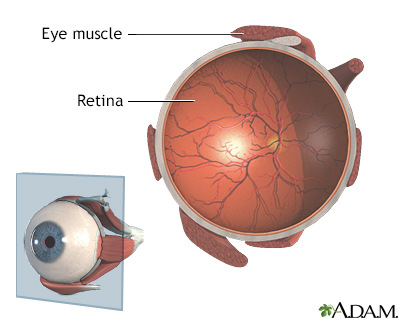Central serous choroidopathy
Central serous retinopathy; Central serous chorioretinopathy
Central serous choroidopathy is a disease that causes fluid to build up under the retina. This is the back part of the inner eye that sends sight information to the brain. The fluid leaks from the blood vessel layer under the retina. This layer is called the choroid.
Images

I Would Like to Learn About:
Causes
The cause of this condition is unknown.
Men are affected more often than women, and the condition is most common at around age 45. However, anyone can be affected.
Stress appears to be a risk factor. Early studies found that people with aggressive, "type A" personalities who are under a lot of stress may be more likely to develop central serous choroidopathy.
The condition can also occur as a complication of steroid drug use.
It has recently been reported after vaccination for COVID-19, although cause and effect could not be proven.
Symptoms
Symptoms may include:
- Dim and blurred blind spot in the center of vision
- Distortion of straight lines with the affected eye
- Objects appearing smaller or farther away with the affected eye
Exams and Tests
Your health care provider can most often diagnose central serous choroidopathy by dilating the eye and performing an eye exam. Fluorescein angiography confirms the diagnosis.
This condition may also be diagnosed with a noninvasive test called ocular coherence tomography (OCT).
Treatment
Most cases clear up without treatment in 1 to 2 months. Laser treatment or photodynamic therapy to seal the leak may help restore vision in people with more severe leakage and vision loss, or in those who have had the disease for a long time.
People who are using steroid drugs (for example, to treat autoimmune diseases) should stop using these drugs, if possible. Do not stop taking these medicines without first talking to your provider.
Treatment with non-steroidal anti-inflammatory (NSAID) eye drops may also help.
Outlook (Prognosis)
Most people recover good vision without treatment. However, vision is often not as good as it was before the condition occurred.
The disease returns in about one half of all people. Even when the disease returns, it has a good outlook. Rarely, people develop permanent scars that damage their central vision.
Possible Complications
A small number of people will have complications from laser treatment that impair their central vision. That is why most people will be allowed to recover without treatment, if possible.
When to Contact a Medical Professional
Contact your provider if your vision gets worse.
Prevention
There is no known prevention. Although there is a clear association with stress, there is no evidence that reducing stress can help prevent or treat central serous choroidopathy.
Related Information
RetinaReferences
Bahadorani S, Maclean K, Wannamaker K, et al. Treatment of central serous chorioretinopathy with topical NSAIDs. Clin Ophthalmol. 2019;13:1543-1548. PMID: 31616132 pubmed.ncbi.nlm.nih.gov/31616132/.
Fowler N, Mendez Martinez NR, Pallares BV, Maldonado RS. Acute-onset central serous retinopathy after immunization with COVID-19 mRNA vaccine. Am J Ophthalmol Case Rep. 2021;23:101136. PMID: 34151047 pubmed.ncbi.nlm.nih.gov/34151047/.
Kalevar A, Agarwal A. Central serous chorioretinopathy. In: Yanoff M, Duker JS, eds. Ophthalmology. 5th ed. Philadelphia, PA: Elsevier; 2019:chap 6.31.
Lam DSC, Boon CJF, Radke NV, van Dijk EHC. Central serous chorioretinopathy. In: Sadda SVR, Sarraf D, Freund KB et al, eds. Ryan's Retina. 7th ed. Philadelphia, PA: Elsevier; 2023:chap 73.
Spaide RF, Gemmy Cheung CM, Matsumoto H, et al. Venous overload choroidopathy: a hypothetical framework for central serous chorioretinopathy and allied disorders. Prog Retin Eye Res. 2022;86:100973. PMID: 34029721 pubmed.ncbi.nlm.nih.gov/34029721/.
Tamhankar MA. Visual loss: retinal disorders of neuro-ophthalmic interest. In: Liu GT, Volpe NJ, Galetta SL, eds. Liu, Volpe, and Galetta's Neuro-Ophthalmology. 3rd ed. Philadelphia, PA: Elsevier; 2019:chap 4.
BACK TO TOPReview Date: 8/22/2022
Reviewed By: Franklin W. Lusby, MD, Ophthalmologist, Lusby Vision Institute, La Jolla, CA. Also reviewed by David C. Dugdale, MD, Medical Director, Brenda Conaway, Editorial Director, and the A.D.A.M. Editorial team.

Health Content Provider
06/01/2025
|
A.D.A.M., Inc. is accredited by URAC, for Health Content Provider (www.urac.org). URAC's accreditation program is an independent audit to verify that A.D.A.M. follows rigorous standards of quality and accountability. A.D.A.M. is among the first to achieve this important distinction for online health information and services. Learn more about A.D.A.M.'s editorial policy, editorial process and privacy policy. A.D.A.M. is also a founding member of Hi-Ethics. This site complied with the HONcode standard for trustworthy health information from 1995 to 2022, after which HON (Health On the Net, a not-for-profit organization that promoted transparent and reliable health information online) was discontinued. |
The information provided herein should not be used during any medical emergency or for the diagnosis or treatment of any medical condition. A licensed medical professional should be consulted for diagnosis and treatment of any and all medical conditions. Links to other sites are provided for information only -- they do not constitute endorsements of those other sites. © 1997- 2024 A.D.A.M., a business unit of Ebix, Inc. Any duplication or distribution of the information contained herein is strictly prohibited.
